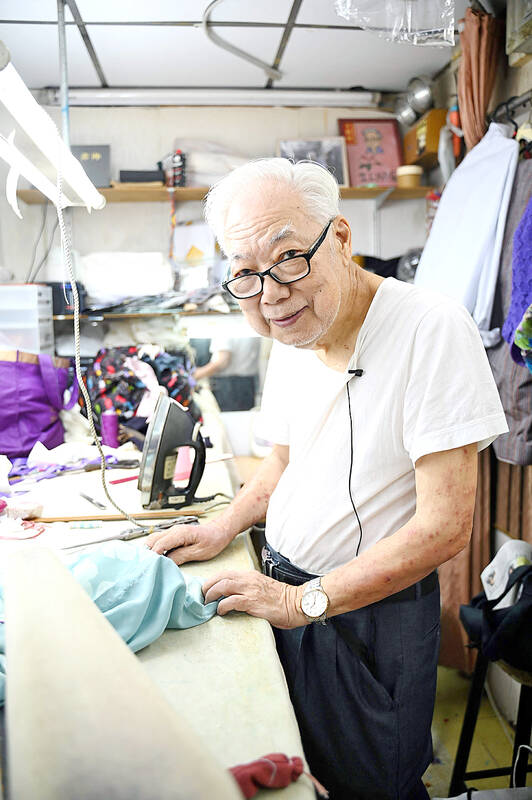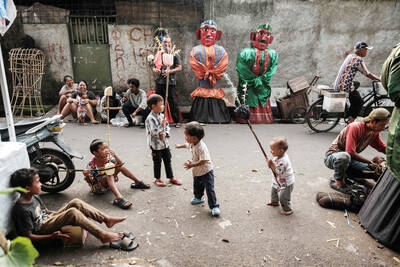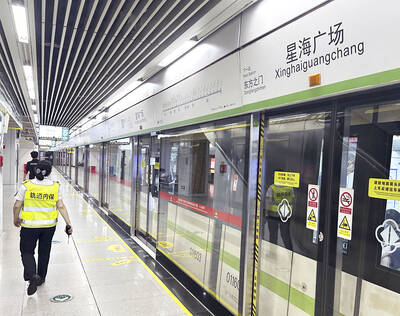Bent over a magenta chiffon fabric, an elderly Hong Kong tailor wearing thick glasses meticulously stitched on embroidered butterflies, working to transform the shimmering material into an elegant, high-collared Chinese dress known as a cheongsam.
Aged 88, Yan Kar-man (殷家萬) is one of Hong Kong’s oldest master tailors of the cheongsam — literally “long clothes” in Cantonese — a dress recognizable for its form-fitting silhouette which was famously featured in Wong Kar-wai’s film In the Mood for Love.
Experts say the silver-haired tailor is among about 10 remaining makers of cheongsam in Hong Kong, which in the mid-1960s used to have about 1,000, according to records from the Shanghai Tailoring Workers General Union.

Photo: AFP
However, after dressing generations of women ranging from housewives to movie stars like Michelle Yeoh (楊紫瓊) and Shu Qi (舒淇), Yan has decided to hang up his measuring tape soon — by the end of this month at the earliest.
“I can’t see clearly — my eyes are not working well, and neither am I. I have to retire,” he said as he stooped closer to his sewing machine to tack on an embroidered border on the dress.
With about 10 more dresses to finish, Yan hesitated to give an exact closing day for his tiny workshop located in the bustling Hong Kong commercial district of Jordan.

Photo: AFP
Evolved from the long robes worn by Manchurian people in China’s Qing Dynasty, the cheongsam has dominated the wardrobes of ordinary Chinese women for much of the 20th century since it was popularized in Shanghai in the 1920s.
Its high-neck collars, knee-length slits and streamlined fits evoked a sense of city glamour, and by the 1960s the dress was everywhere in Hong Kong.
“Women would wear them to shop in wet markets,” recalled Yan, whose workshop walls are plastered with photos of beauty pageant queens wearing his dresses.
Some of his celebrity customers have even reached out for major life events — like Liza Wang (汪明荃), a Hong Kong diva nicknamed “Big Sister” in entertainment circles, who has been his client for three decades.
“I didn’t know it was for her wedding when I made her a dress with one of her scarves and turned the scraps into a tie for her groom,” Yan said.
Born in Jiangsu Province, China, north of Shanghai, Yan was 13 when his uncle brought him to Hong Kong in 1949 to work as an apprentice in a workshop, where the school dropout was discovered to be a young talent.
At that time, the trade for cheongsam was so common and stable that Yan recalled a plain design would cost “just a few [Hong Kong] dollars.”
Western fashion became popular after World War II, and the rise of the garment manufacturing sector in Hong Kong squeezed the cheongsam out of the fashion limelight while pushing tailoring workshops out of business.
Today, the traditional technique to make the dress is “critically endangered,” said Brenda Li, an adviser to the Hong Kong Cheongsam Association.
“Hong Kong’s cheongsam-making has developed its own style and tradition in the past century, merging skills of dimensional cutting from the West,” she said.
“Few people still wear and care about it, but we want to preserve it no matter how niche it has become because it’s part of our culture,” she added.
Although cheongsam-making technique has been recognized as part of Hong Kong and China’s cultural heritage, Yan said the withered trade offers little chance to pass on his craft.
“You can’t make a living by making qipao because it’s no longer the trend,” Yan said, using the Mandarin word for the dress.
The master — who also teaches at a learning center near his shop — said his students were “far from ready to make real clothes for clients.”
Nowadays, orders typically come from older women who need a statement dress to attend their children’s weddings, and each piece takes Yan weeks to finish and costs several thousand Hong Kong dollars.
“How many old clients are still out there, and how many pieces of such detailed work can you make every month?” Yan asked rhetorically. “My generation is mostly gone.”

In the sweltering streets of Jakarta, buskers carry towering, hollow puppets and pass around a bucket for donations. Now, they fear becoming outlaws. City authorities said they would crack down on use of the sacred ondel-ondel puppets, which can stand as tall as a truck, and they are drafting legislation to remove what they view as a street nuisance. Performances featuring the puppets — originally used by Jakarta’s Betawi people to ward off evil spirits — would be allowed only at set events. The ban could leave many ondel-ondel buskers in Jakarta jobless. “I am confused and anxious. I fear getting raided or even

Kemal Ozdemir looked up at the bare peaks of Mount Cilo in Turkey’s Kurdish majority southeast. “There were glaciers 10 years ago,” he recalled under a cloudless sky. A mountain guide for 15 years, Ozdemir then turned toward the torrent carrying dozens of blocks of ice below a slope covered with grass and rocks — a sign of glacier loss being exacerbated by global warming. “You can see that there are quite a few pieces of glacier in the water right now ... the reason why the waterfalls flow lushly actually shows us how fast the ice is melting,” he said.

RISING RACISM: A Japanese group called on China to assure safety in the country, while the Chinese embassy in Tokyo urged action against a ‘surge in xenophobia’ A Japanese woman living in China was attacked and injured by a man in a subway station in Suzhou, China, Japanese media said, hours after two Chinese men were seriously injured in violence in Tokyo. The attacks on Thursday raised concern about xenophobic sentiment in China and Japan that have been blamed for assaults in both countries. It was the third attack involving Japanese living in China since last year. In the two previous cases in China, Chinese authorities have insisted they were isolated incidents. Japanese broadcaster NHK did not identify the woman injured in Suzhou by name, but, citing the Japanese

RESTRUCTURE: Myanmar’s military has ended emergency rule and announced plans for elections in December, but critics said the move aims to entrench junta control Myanmar’s military government announced on Thursday that it was ending the state of emergency declared after it seized power in 2021 and would restructure administrative bodies to prepare for the new election at the end of the year. However, the polls planned for an unspecified date in December face serious obstacles, including a civil war raging over most of the country and pledges by opponents of the military rule to derail the election because they believe it can be neither free nor fair. Under the restructuring, Myanmar’s junta chief Min Aung Hlaing is giving up two posts, but would stay at the